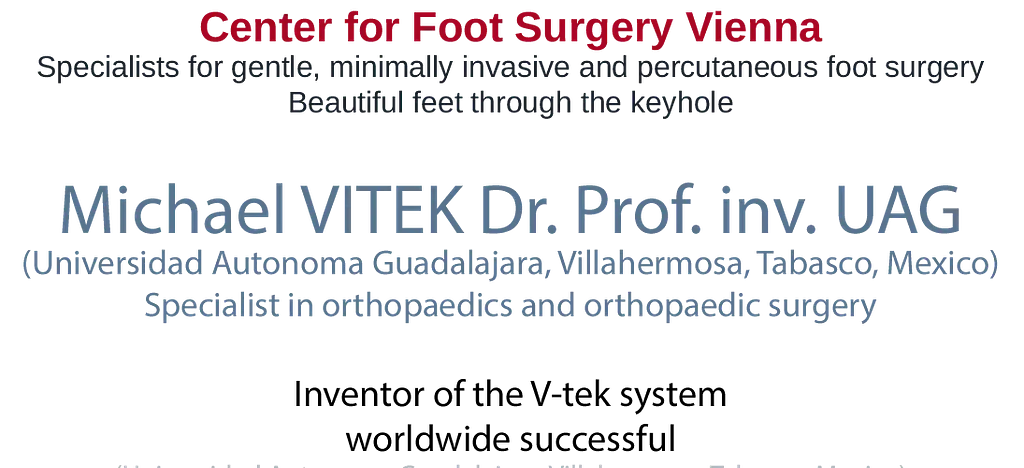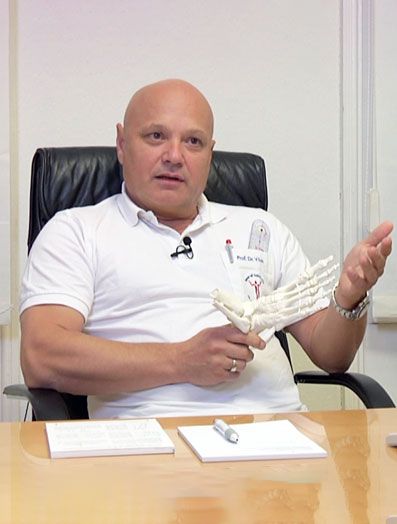Toe Lengthening
Short toes are either congenital or iatrogenic (caused by surgery, when the toes were shortened too much). Congenital short toes (brachydaktylie) and/or short metatarsal bones (brachymetatarsie) are treated with bone extensions with special bone cuts.
Unfortunately, hammer toes and other toe deformities are still treated with the removal of joints and other important bone parts in many surgeries. Often this resembles a mutilation and we strongly reject this very old method (Described in 1922)!
However, patients often visit us having horribly mutilated and shortened toes. See examples below and "hammer toes" in the “horror closet”. These patients ask us for a redress and for re-extension of the short toes. The solutions are possible but sometimes difficult.
The operations range from real extensions of the toes, to "re-mounting" a dislocated toe on its corresponding metatarsal head, leading to a relative extension of the toe, up to tendon dislocations for the stretching of a flexibly shortened toe.
Example I:
BEFORE (pictures 1 and 2): Congenital brachymetatarsia of the 4th toe on both sides and on the 3rd toe on the right.
AFTER (pictures 3 and 4): All 3 toes were successfully lengthened. This is what the feet look like 11 weeks after the operation. The patient is very satisfied.
After (picture 5): Final result after a few months.
Example II:
BEFORE (left picture): Congenital brachymetatarsia of the 4th toe on the left. The toe is not only shortened, but also sticks up and does not reach the ground.
AFTER (right picture): The foot 9 weeks after the surgical lengthening. The 4th toe has an optimal length and is now in line with the neighboring toes. The patient is overjoyed!
Example III:
BEFORE (left picture): Congenital brachymetatarsia of the 4th toe on the left side.
AFTER (right picture): Sensational result. This is how the foot looks just 4 weeks after the operation. The scar is already only a delicate line and will soon no longer be visible.
Example IV:
BEFORE (pictures 1 and 2): Again a brachymetatarsis (congenital, too short metatarsal bone). As in almost all cases it affects the 4th toe and the patients are mostly female. This patient, Mrs. L (33 years old) decided to have an extension surgery with us. The younger the patients are, the better the conditions for such an operation.
AFTER (pictures 3 and 4): This is how Mrs L's foot looks like 4 weeks after the operation. We have lengthened the 4th metatarsal and thus the toe.
The result is very good. The scar will soon have faded.
Example V:
Brachymetatarsis (congenital, too short metatarsal bone) 4 left in Mrs. K (23 years). Right picture: Intraoperatively the correct length is adjusted in a single session. The traction thread is removed before the end of the operation. It helps to adjust the length and is no longer needed after the operation.
Example VI:
Patient N (29 years old): The big toe is very long, somewhat twisted and appears somewhat clumsy in relation to to toes 2 and 3, which are very short.
The picture on the right was taken 3 weeks after the operation: We shortened the big toe, derotated it and straightened it. The 2nd and 3rd toe was lengthened in the same session. The result is cosmetically and functionally very satisfactory.
Example VII:
Patient X (18 years) Before and 3 months after extension of the 4th toe.
Example VIII:
This patient had a hallux valgus combined with a very short 3rd toe. We lengthened the toe and the metatarsal about 7 mm, which is nearly the maximum at one stage surgery. If a longer distance is necessary, two or more surgeries or an external distractor are used, otherwise nerves and vessels can be damaged.
Left: Before and after the surgery.
Right: Please note the nice toe alignement and the narrow foot. This picture was taken 6 weeks after surgery, there is almost no swelling, the patient is fully mobile and wearing normal shoes. The big toe is straight and does not push the 2nd toe anymore.
X-rays before and after surgery. All implants belong to the V-tek system, developed by Michael Vitek.
Example IX:
Situation after 6 operations, and each time shortening of the toes
This patient had to undergo 6 operations in different hospitals, where her toes were repeatedly shortened, because hammertoes kept forming. Suddenly, the toes were too short (amazing, right?) and stood in all directions. The big toe and the IV toe were grotesquely long in comparison. This caused not only cosmetic concerns, but also problems in shoes and during walking, due to the lost function of the toes.
We shortened the IV toe on both sides and extended the II and III toe on both feet by a bone transplant and also straightened the toes. Both the cosmetic, and particularly the functional result is impressive.
After a surgical "correction" of the forefoot
This patient had also the hallux and the hammertoe II operated on in another hospital. Obviously, the patient was not satisfied with the results.
We performed a permanent straightening of the big toe and brought the II toe by means of tendon transfer to the ground, thus extending the II toe.
After an operation in another hospital, the toes 2 and 3 are much too short and they lost their function
This 62-year-old patient had had problems with her left foot since early childhood. Previous external operations did not help and over the years her foot became completely deformed. In the end, she found it increasingly difficult to walk, was in severe pain and her beloved walking was out of the question. She was advised to have the toes at the top amputated, as they no longer had any function anyway.
After our operation, the patient was pain-free and walking well within a few days. The picture shows the foot 10 weeks after our reconstruction. All toes are still attached, even reach the ground and take part in the important walking process - namely the push-off. The lady is delighted to be able to go on long walks.



